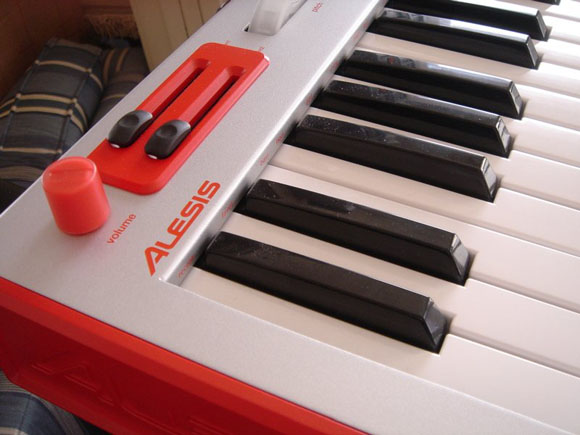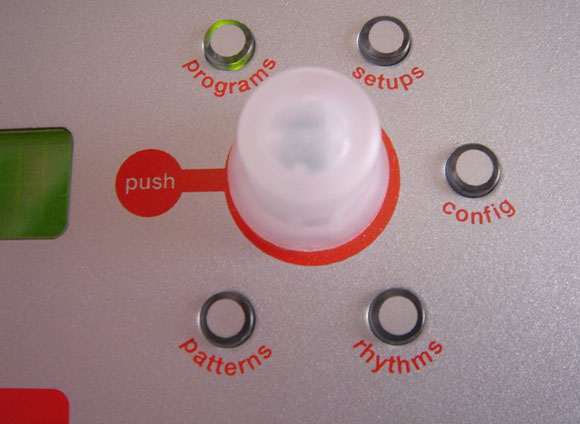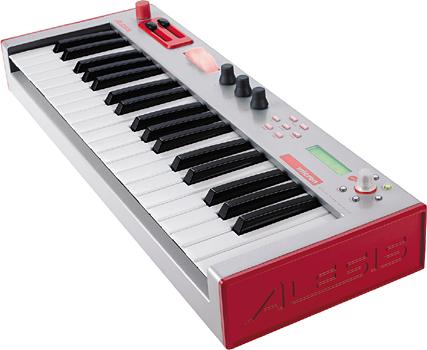
What does a hardware synth have to do to compete with
software these days? How about offer the same fantastic virtual analog
sound for about the same price, for starters?
The Alesis Micron is the kid brother to the Alesis Ion
synth, with the exact same 8-voice, 4-part multitimbral VA engine. Each
voice has 3 oscillators, 2 multimode filters, 3 envelopes, 3 LFOs,
sample and hold, and a tracking generator.
There are filters galore on offer here, 20 different types in all, many
are nearly exact replicas of filters from Moog, ARP, Oberheim, and
Roland. Alesis has even modeled in the drift associated with analog
oscillators. Rudimentary FM capabilities allow you to create fairly
realistic pianos, organs, and bell tones, a real plus in a synth this
inexpensive. One thing unique to the Ion/Micron is being able to
access all of these different sounding filters in a single synth.
Flexible envelopes provide control over your sound sculpting. A mod
matrix delivers much of the power of the semi-modular synths of old.
The synth can also be used to process external signals. (read more)

The Micron packs all off this into an even more compact 37-key package
that also contains a phrase sequencer and an analog-style drum machine.
It has the same 40-band vocoder and arpeggiator found in the Ion, and
the same effects, with the addition of reverb.
You trade-off the "knob for every job" and large LCD user interface of
the Ion for a single data knob and two-line LCD for editing. In actual
use, the control system on the Micron is quite ingenious. Keys are used
for quickly navigating to particular sections when editing or switching
between patch banks. It's a breeze once you've gotten used to it.
Whether this works for you will depend largely on how you use a synth.
It's not quite as much fun to craft your own sounds on the Micron as on
the Ion, but its more than doable and the lack of controls is not
unprecedented in a performance synth. The Moog Source, perhaps the most
direct ancestor, was a similar size and employed a similar method of
data entry.
Performance controls include two mod sliders (m1 and m2) and a pitch
bend wheel, and three endless analog knobs, labeled x,y,z that can
control envelope attack, filter resonance, or just about anything you
want. By default m1 is mapped to vibrato and m2 to filter cutoff in
most patches but they are freely assignable. Some will hate their
horizontal orientation but, if you think about it, it's actually a more
intuitive way to indicate pitch. There are also octave select buttons,
a latch button, a tap-tempo button and a button for on-the-fly phrase
recording.

Yes, the Micron is the kid brother to the Ion but there's more here
than hand-me downs. In fact, I can see existing Ion users adding a
Micron to their set-up, particularly if they gig a lot. Since the
Micron contains the exact same sound engine as the Ion, patches can be
freely swapped. You could, for example, use the superior editing
interface of the Ion to build patches for the Micron.
This is not only a great synth for US$400 street, it's a great synth
period, with the best analog emulation I've ever heard. Put this baby
on the second tier of your keyboard stand and you'll have the perfect,
bass, lead, and pad machine. Due perhaps to its size and low price, a
lot of people are wondering how the Micron stacks up to the microKORG.
I've owned both and aside from the more intelligible vocoder in the
microKORG and the ability to run on batteries, there's simply no
comparison. The Micron bests the microKORG with decent full size synth
action keys (not the best I've ever experienced, but far from the
worst), and a much warmer, truer analog sound. The microKORG is also
limited to 128 sounds while the Micron can store hundreds. Some people
like the grittier sound of Korg's analog emulation (and I've still got
an ElecTribe in my collection for that) but if you're looking for
analog sound that is as close as digital comes, this is the one.
San Francisco-based tech writer and musician Lee Sherman has written for magazines like Keyboard and Electronic Musician — and even NeXTWorld. Check out his great blog Music Matters.